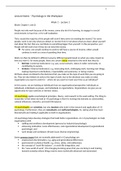Class notes
Lecture Notes Psychology in the Workplace (minor Psychology in Society) - PSMIN03
- Course
- Institution
Extensive notes of the lectures of the course Psychology in the Workplace (PSMIN03), part of the minor Psychology in Society. This document includes notes from lectures from week 1 up to and including week 6.
[Show more]



